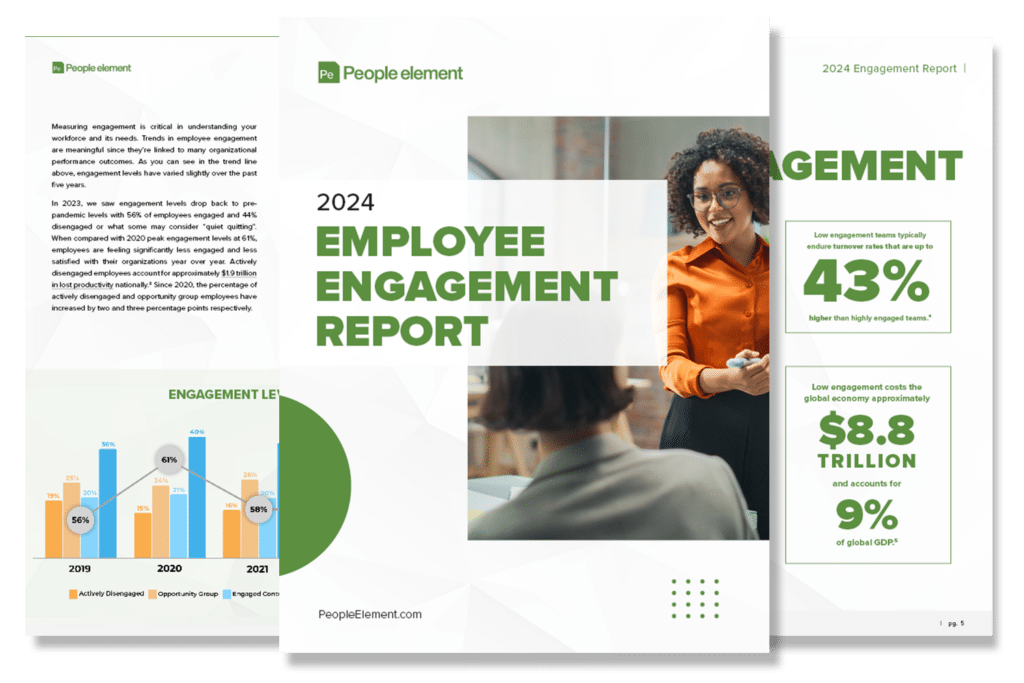Organizational success depends on agilely responding to the wide variety of factors in the business world. Market conditions, regulations, competitors, customers, suppliers; each of these requires continual monitoring and adjustments to remain profitable. Additionally, you must monitor internal factors, like your workforce, to maintain engagement and improve productivity. The best leaders know that efficiently staying on top of, and responding to, the factors impacting engagement and productivity requires the use of continuous listening, a strategic approach of gathering and acting on employee feedback.
Continuous Listening Definition:
Continuous listening means gathering employee feedback more frequently than an annual engagement survey; this much is widely accepted. After that there are dozens of directions in which you can go. Organizations that achieve the most success are those that gather feedback across the continuum of the employee lifecycle and employee experience, from pre-hire through exit, and are asking the right questions of the right population at the right times. This gives you great insight into the unique feelings and perspectives of many important groups within your employee population.
Before you can effectively put this into practice, however, consider these tips to best set yourself up for success:
- Harness Perspectives Across the Employee Lifecycle:
Every organization has employees who are at different lifecycle stages of their employment, from onboarding to exiting and everything in between. Feedback from everyone of is valuable. Continuous listening allows you to gather overall feedback from everyone (through a traditional engagement survey or pulse) as well as target certain populations for feedback specific to their experience at that time. For example, you might gather feedback from new hires at 30 days of tenure with a focus on expectations versus reality of the job, or ask exiting employees about what is driving turnover. Each touchpoint throughout an employee’s experience provides the opportunity to collect targeted data for use in improving your organization.
- Craft the Perfect Mix of Questions:
When selecting the specific questions or statements to create a survey (we call them all “items”), take care to ensure the items will provide actionable feedback from the target population. Sometimes it makes sense to include items covering a wide variety of topics in one survey rather than several. The right platform will help streamline the process for all those involved by providing customizable survey templates and additional items, as well as minimizing survey fatigue in participants by simplifying the response process. Gathering feedback will produce plenty of opportunities for action, so it is best to minimize administration time so you can focus on taking action and seeing results.
- Choosing your survey cadence
This part can be tricky, as you want to survey frequently enough to capture trends over time so you know whether things are improving or can respond quickly when they aren’t, while also minimizing the administrative burden and giving yourself enough time to respond to the feedback provided. Full engagement surveys typically go out annually, with a pulse check-in at the 6-month point. If you choose to use an engagement pulse survey, these are shorter and can therefore go out more frequently, as often as monthly, as this gives enough time for managers to act on feedback before it’s time for the next pulse.
Understanding The Value in Continuous Listening
Foster an environment of open communication by implementing the practice of Continuous Listening. This proactive approach enables companies to continuously collect, analyze, and act upon feedback from employees in every life cycle.
Doing this allows you to positively impact the entire employee experience. And that’s the ultimate goal, right? Here are just a few examples of how you can leverage the employee lifecycle to create a continuous listening strategy that works:
- Do you know if your new hires are having the onboarding experience you want them to have? You spend a good amount of money on recruiting and hiring great people and one of the fastest ways to disengage a new hire is when their expectations don’t match the reality of the job. Collect feedback after the first few months of tenure when the experience is still fresh. Find out what onboarding tweaks you can make that will have the best impact on your new hires.
- Curious to know what exactly is driving your turnover and what specific actions will help slow it down? Ask your exits, not your current employees. Exiting employees are the only population who will tell you why they DID leave, not why they MIGHT leave. Confidence increases when you can report quantitative data on top of employee exit factors, and you don’t have to assume that what people are telling their manager as their exit reason is true (spoiler: it’s often not true).
- Do you need to understand employee feelings and perceptions as you build out your diversity & inclusion strategy? Let me rephrase… You need to understand employee feelings and perceptions as you build out your diversity & inclusion strategy. Ask your full population specific questions to find out. What better way to show your people that your D&I strategy isn’t just lip service than to bring them in on the strategy by listening and acting on their feedback?
- How engaged are your employees? When employees are engaged, customer satisfaction, productivity, and profits increase while absenteeism and turnover decrease significantly. You risk spinning your wheels if you start trying to increase engagement without knowing what specific actions you should take to improve it. Conducting a full employee engagement survey is still an incredible tool in your continuous listening toolbox.
Continuous Listening: Real-Life Strategy and Benefits
Let me share a true example of how one of my amazing clients was able to take advantage of continuous listening across the employee lifecycle. They gather specific feedback from their new hires and exits, in addition to other current employee surveys. One question they ask on their new hire survey is whether people are having new hire check-ins with their manager or not. This one question gives them visibility into which departments may need more support for getting check-ins done and whether the rest of the new hire experience is different depending on whether someone has their manager check-ins or not. As you might suspect, there is a difference. A big one.
Since they also capture exit feedback, they were able to see if the new hire check-ins impacted employee retention or not. And if you guessed that they do, you’re absolutely right. With this continuous listening feedback across the employee lifecycle, we go from…
“I think doing new hire manager check-ins is good because I read about their efficacy.”
To…
“Our managers checking in with new hires positively impacts the onboarding experience. It also impacts employee retention because we see that new hires who receive manager check-ins are 1.45 times more likely to stay at least one year than those who do not.” (mic drop)
That’s it – that is continuous listening. No need to over-complicate it; it’s as simple as leveraging feedback from the entire employee lifecycle to help guide decisions and action. To learn more about exactly how to put feedback into action, join me in my next article where I discuss how to build and execute a continuous listening strategy that improves the employee experience.
Building and Executing on your Strategy
For an effective continuous listening strategy that avoids survey fatigue, you need to cover these three things in the following order: Ask, Listen, and Act. That’s the secret sauce.
Below I’ve provided introspective reference points which will allow you to build a continuous listening strategy that will work for your organization.
- Aligning questions with the audience at the right time:
- What organizational questions do I have that employee perspectives can provide answers to? (A few examples can include: Why are employees leaving? Do all employees feel like they are included and they belong? Are the changes we made to our compensation plan for <insert job title here> having the right impact? What are people’s first impressions of our company when they’re hired?)
- Does it make sense to collect feedback on an ongoing basis, or just once?
- To get the right data to my questions, who are the right people to collect feedback from?
- If I’ve picked a date to start collecting feedback, have I made sure there aren’t other surveys or major events happening at the same time that could negatively impact participation?
- Listen and understand your feedback
- Do I have the right tools to be able to easily understand what the feedback is telling us and what we need to do about it?
- Do my listening tools provide real-time data in a way that is simple to use?
- Who needs to have access to our feedback results and action planning tools?
- Act on that feedback, and don’t forget to let your employees know that you’re acting on that feedback!
-
- Who will be in charge of action planning? Are they bought into the idea of acting on employee feedback?
- How and when will we communicate next steps back to our employees?*
- Will we need a follow-up survey to check progress on our actions, or to gauge perceptions after action takes place?
*This is a real pro tip – If you take action but neglect to tell your employees that you’re acting on their feedback, you’re putting your continuous listening strategy at risk. Why? 2020 People Element data tells us that more than one out of three employees do not feel like their opinions and suggestions are valued in their organization. What better way to turn that number around than by telling them what is being done as a direct result of their feedback?
Transforming Survey Data into Action
This action step is the one that requires some lifting. Employee feedback is unique to every organization based on the culture, size, leadership, industry, etc. There is no single prescriptive solution for taking action because the best actions are the ones that you believe are doable and will work for YOUR people. The great news though, is that you don’t have to do this on your own either. You just need to commit to action and get the right people involved to get you the results you want.
I will share a great way to act that will get you results. But first, I want to talk about commitment to action. Here’s a riddle that I’ve shared with several clients. It is a guaranteed groaner, but it drives home a strong point:
There are three frogs sitting on a log. Two of them decide to jump off. How many are left on the log?
The answer is three. Why? Because “decide to jump” and “jump” are very different things.
I love this riddle because too many times I see “decide to” without action. My colleagues and I are good at getting leaders interested in and motivated to act upon employee feedback data. I know all too well how easy it is to go back to your desk and become consumed with all the other work and push aside taking action. Then one day you look up and it’s time for your next round of employee feedback.
The question is this: How do you take that first step from deciding to doing?
I’ve seen success with these three steps:
- Assign an executive sponsor. While everyone is still excited and motivated, choose a member of the leadership team who will sponsor the action step. The executive sponsor is NOT the person who creates the plans or is responsible for executing the action. They’re the leader who will support the work that goes into creating action plans and hold people accountable.
- Create a cross-functional action committee. Gather a group of employees together (volunteer or “voluntell”) who will be responsible for brainstorming ideas and bringing recommended action plans back to the leadership team for approval. The team should include people who can represent many diverse perspectives – different departments, backgrounds, tenures, levels of expertise, etc. The benefits of a committee like this are immense. You get You’ll have immediate employee buy-in on your action plans since employees are the ones creating the plans.The executive sponsor does not need to attend every committee meeting, but they should attend the first meeting to cover the following points:
- Define the committee’s purpose and objectives.
- Provide an overview of the issues that the committee will be working to improve.
- Set expectations (timing, specific deliverables, etc.).
- Show support for the committee’s time and efforts.
- Communicate your action progress to employees. This doesn’t have to be all the time, and doesn’t have to be all the details. It is a good idea to send out a communication once a quarter letting people know what you’re acting on and how it will impact them. Here is what you accomplish with this step
- Employees feel like their opinions are valuable.
- People see that it’s worth their time to provide feedback, so they will be likely to do it again next time you ask.
- You keep yourselves accountable to the plans that have been created.
There are a lot of details packed into these steps. If you are interested in hearing more about how to move from deciding to acting, let us know. We are here for you and would love to chat!





